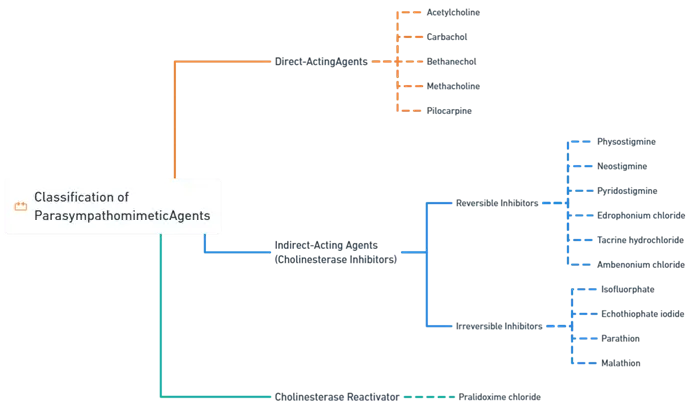- Parasympathomimetic agents, also known as cholinergic agonists, are drugs that mimic the action of the parasympathetic nervous system (PNS) by stimulating cholinergic receptors (muscarinic and/or nicotinic).

A. Direct-Acting Parasympathomimetic Agents
- These agents bind directly to cholinergic receptors, mimicking the effect of acetylcholine.
-
Mechanism
- Act as agonists at muscarinic (and in some cases nicotinic)
- Not dependent on endogenous acetylcholine levels.
-
Examples:
- Acetylcholine
- Carbachol
- Bethanechol
- Methacholine
- Pilocarpine
B. Indirect-Acting Parasympathomimetic Agents (Cholinesterase Inhibitors)
- These agents inhibit acetylcholinesterase (AChE), the enzyme that breaks down acetylcholine.
- This leads to an increase in ACh levels at synapses, enhancing parasympathetic activity.
- Subtypes:
-
Reversible Cholinesterase Inhibitors
- Bind non-covalently or reversibly to the active site of AChE.
- Duration of action is short to moderate.
- Examples:
- Physostigmine
- Neostigmine
- Pyridostigmine
- Edrophonium chloride
- Tacrine hydrochloride
- Ambenonium chloride
-
Irreversible Cholinesterase Inhibitors
- Typically, organophosphates.
- Bind covalently to AChE, causing long-lasting inhibition.
- Require a reactivator to reverse the inhibition.
- Examples:
- Isofluorphate
- Echothiophate iodide
- Parathion
- Malathion
C. Cholinesterase Reactivator
- Used in the treatment of poisoning by irreversible cholinesterase inhibitors.
-
Mechanism
- Reactivates AChE by removing the phosphate group from the active site.
-
Example:
- Pralidoxime chloride
-
Thank you for reading from Firsthope's notes, don't forget to check YouTube videos!
